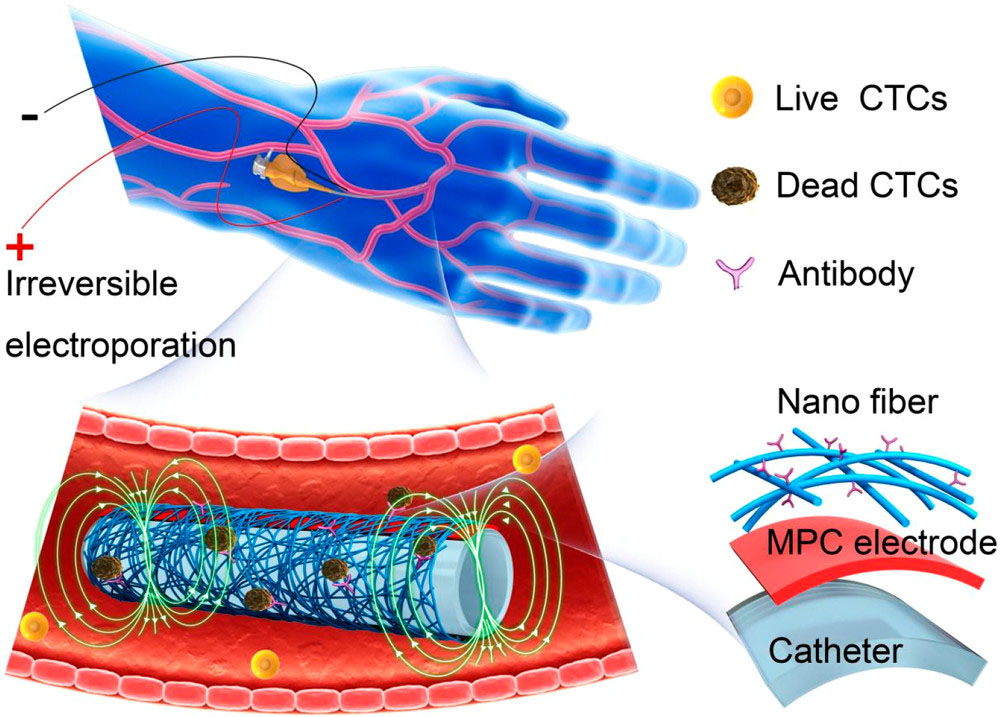| Mar 28, 2022 |
An electronic nanofiber catheter to kill circulating tumor cells
(Nanowerk News) Metastasis – the process of cancer spreading from its original site to distant tissues – is caused by marauding tumor cells that break off from the primary tumor site and ride in the bloodstream to set up colonies in other parts of the body. These breakaway cancer cells in the peripheral blood are known as circulating tumor cells (CTCs).
|
|
Detecting and analyzing CTCs can provide critical information for managing the spread of cancer and monitoring the effectiveness of therapies
|
|
Peripheral blood contains billions of red blood cells and detecting, removing and destroying the tumor cells hidden in this bloodstream with high specificity is a very difficult challenge. Currently, there are three in vivo methods for capturing CTCs – via intravascular microfluidic chip to harvest CTCs; injection and capture with a nanowire of magnetic nanoparticles attaching to CTCs; and using biofunctionalized needles.
|
|
All these methods have disadvantages either because they are very slow or have significant side effects.
|
|
In a new approach, researchers have developed a flexible electronic catheter that integrates electrospun nanofibers with irreversible electroporation to achieve efficient CTC enrichment and complete killing of CTCs.
|
|
They report their findings in ACS Nano ("Flexible Electronic Catheter Based on Nanofibers for the In Vivo Elimination of Circulating Tumor Cells").
|
 |
| Schematic diagram of in vivo enrichment and elimination of CTCs using the flexible electronic catheter. The metal−polymer conductor was coated on the surface of the indwelling catheter to form electrodes to realize irreversible electroporation. We used the electrospinning method to generate nanofibers on the surface of the catheter to protect the metal−polymer conductor electrode and improve the capturing efficiency. At last, the surface of the nanofibers was modified with the EpCAM antibody to improve specific biorecognition and cell adhesion. (Reprinted with permission by American Chemical Society)
|
|
The team fabricated their flexible electronic catheter by integrating electrospun nanofibers with liquid metal−polymer conductor electrodes. They modified the surface of the nanofibers with an epithelial cellular adhesion molecule (EpCAM) antibody on the surface to improve specific biorecognition and cell adhesion.
|
|
This catheter can effectively kill CTCs in the bloodstream via irreversible electroporation.
|
|
The authors point out that, differing from conventional ablation therapies such as radio-frequency ablation, cryotherapy, or thermal ablative modalities, irreversible electroporation has the following advantages: it does not harm the extracellular matrix, vessels, or nerves; it is unaffected by the heat sink effect of blood vessels in the proximity of the ablation zone; and it does not result in overall harm to the host.
|

 By
Michael
Berger
– Michael is author of three books by the Royal Society of Chemistry:
Nano-Society: Pushing the Boundaries of Technology,
Nanotechnology: The Future is Tiny, and
Nanoengineering: The Skills and Tools Making Technology Invisible
Copyright ©
Nanowerk LLC
By
Michael
Berger
– Michael is author of three books by the Royal Society of Chemistry:
Nano-Society: Pushing the Boundaries of Technology,
Nanotechnology: The Future is Tiny, and
Nanoengineering: The Skills and Tools Making Technology Invisible
Copyright ©
Nanowerk LLC
